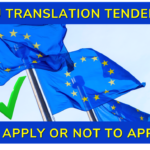
How to impress potential customers to buy YOUR translation services
General
There are many good translation service providers on the global market offering similar services and language combinations. As in any other segment of the service industry, there is a lot of fish in the red sea of competition.
If we look at translation provider websites, company profiles or personal profiles on LinkedIn, it’s extremely hard to choose an LSP or a freelancer. And why? Because there is often something missing that would elicit trust in us. Many have rather similar statements and approaches in their sales and marketing communications. Practically, there is no real differentiation, only a very few stand out in the crowd.
So how can you really impress someone that you’re the best choice for their translation needs?
Specialization

The first thing that translation agencies often lack is a clear specialization and experience in several specific fields. For example, if we’re looking for a legal translation of a confidential document about the terms of entry into new markets, we’d immediately look for someone who specializes in legal translation of business contracts, globalization, internationalization, and similar. If you have a problem with your skin, you would probably go to a dermatologist, not a heart surgeon.
Someone who offers a mountain of specializations, and a sea of language combinations doesn’t come across as credible in the first few seconds. And a visitor typically spends around five seconds on a website to form a first impression. And as the saying goes, you can only make a first impression once.
You could visit your own website and LinkedIn profile and view it
through the lens of a potential customer, but try to put yourself
in their shoes really. What would the potential customer see?
One situation, many interpretations
Another important insight is that we’re all different and perceive and interpret reality in countless different ways. This means that each of us has a different pattern or mode of how we’re convinced that we can trust someone.
One of these patterns is what is known as see-hear-read-do. This means that translation service providers should offer a variety of content and approaches to appeal to the potential customer with the following patterns.
See
People with this pattern need to see a graphic, an infographic, a photo, a video of you, or some other evidence. For example, they need to see what you look like, how you do your translations, how you’re organized, and so on, and then they’ll think about doing more research on you. They start to develop trust by watching you.
Make sure you also use words like
♦ see,
♦ visualize,
♦ enlighten,
♦ clarify,
♦ image,
♦ photo,
and the like in your texts, social media posts and blog posts so that these people can see you.
Apparently, there are about 55% of people with this pattern according to Rodger Bailey.
Hear
People with this pattern need to hear your voice or hear about you from other people they trust and from people who have worked with you to sense whether or not you’re trustworthy. That’s why it’s a good idea to post a testimonial and a short video about your company on your website or profile so they can hear your voice.
Make sure you use words like
♦ hear,
♦ ask,
♦ dialog,
♦ discuss,
♦ hear about,
♦ listen,
♦ say,
and the like in your texts, social media posts, and blog posts so that these people can hear you.
About 30% of people have this pattern according to Rodger Bailey.
Read
People with this pattern need a longer textual explanation of your services. This could be a case study in which you describe how you helped your client translate a large project within a few days, and how your large team did their best to complete the project in such a short time.
In doing so, you used modern translation technologies to be absolutely efficient and save the client money.
About 3% of people have this pattern according to Rodger Bailey.
Do
People with this pattern need to test your skills and give you a small task to make sure you’re a good choice for them, because nothing else would convince them. That’s why it’s always a good idea to offer them a free sample translation of, say, 300 words to put them at ease.
Make sure you use words like
♦ try out,
♦ test,
♦ feel,
♦ touch,
♦ first hand,
and the like to give these people an idea of your services.
About 12% of people have this pattern according to Rodger Bailey.
Translation as a service is just as problematic as any other service in the service industry, because people are buying a “pig in a poke.” They never know what the outcome of the service will be until it’s delivered because they can’t touch or try the product before purchase.
And usually, people know that the quality of the service doesn’t depend so much on the company, but on the people working on the project and their intellect and creativity. That is why it’s important:
♦ to put a special focus on marketing
♦ to point out the qualifications and experience of the translators
♦ clearly explain your quality procedures
♦ show that you continuously invest in education and training
Pleasure or pain
Another important pattern to understand human behavior and motivation is pleasure or pain, you know the carrot and stick phrase. This means that some people are strongly motivated to get pleasure or to avoid pain.
Of course, this depends on the context, because some people are motivated by benefits and rewards in their jobs, but in their personal relationships, they’re strongly motivated to avoid trouble or pain.
Carrots
People motivated by pleasure to buy your translation services want to know all the benefits your translation makes possible and the benefits of working with you. People with pleasure motivation triggers get inspired by their goals and future results.
They’ll talk about what they’ll get and have. Interestingly, people with this motivational pattern are good at sales, marketing, teaching, and coaching, and usually don’t like jobs that involve details and analysis, which is why they aren’t drawn to becoming proofreaders and editors, just a hint for business leaders.
Be sure to use words like
♦ benefit,
♦ advantages,
♦ enable,
♦ achieve,
and the like to get the attention of people with this pattern.
Sticks
Those motivated by avoiding or preventing pain will buy your translation so they don’t have to take care of this work themselves, or to avoid problems with customers with expansion into new markets, for example. Even in professions like risk management, medicine, pharmaceuticals, and troubleshooting of any kind, this pattern is common. They’re also good proofreaders and editors, just for your reference.
According to Rodger Bailey, about 40% of people have this pattern and about the same percentage have the carrot motivation pattern, and others fall somewhere in between.
So when you work with clients like this, make sure you use words like
♦ prevent,
♦ avoid,
♦ fix,
♦ solve,
♦ get rid of,
and the like so that people with this pattern resonate with you.
Patterns for marketing, sales and leadership
Of course, there are many more of these patterns, about 25, that are most common. Keep in mind that these behavioral and linguistic patterns are only approximations and that we all have different portions of them depending on context and circumstances. However, they help us immensely in sales, marketing, job profiling, and negotiation so that we can be flexible in communicating with different people and that they understand our message properly.
You probably recognize yourself in all of these patterns to some degree and know what would help you make the right decision to buy the service that you need.
But don’t fall into the trap that other people would do the same. In marketing and sales, the worst approach is to judge by yourself. Always ask or test your audience and be flexible and friendly. Flexibility means stability, and kindness means good feelings. After all, we’re all looking for a good feeling or a solution to a problem when we buy something.
We are here for you
If you want to learn more about how to use your marketing to sell more translation services, visit our Academy workshop Fortify your marketing.
We’re here for you if you want to prevent poor sales and marketing communications. We have several options of collaboration for LSPs with varying stages of development. These options are supported by proven methods and practices based on our 20+ years of experience in the translation and localization industry. This all combined will help you reach your business goals. What do you think?
Get in touch to see us in action!
By the way, how many patterns have you recognized in the paragraph above? 😊















